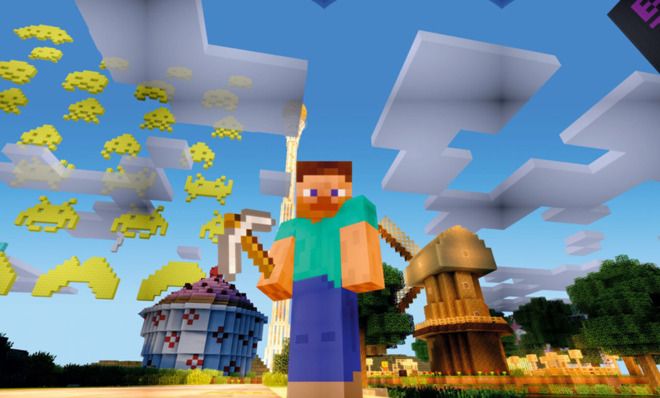Why Microsoft was smart to spend $2.5 billion on a low-fi game based on computerized Lego blocks
The computer industry is changing. Microsoft's acquisition of Minecraft is a heartening sign that the company knows it.

Marcus Persson, better known as Notch, the founder of Mojang, says he doesn't "make games with the intention of them becoming huge hits."
But Minecraft, of course, became a huge hit, which was partly why Microsoft paid a cool $2.5 billion for Mojang, Minecraft's maker, earlier this week.
A deceptively simple game with low-fi graphics, Minecraft has attracted more than 100 million users who get their kicks from building virtual structures out of computerized, Lego-like blocks. Minecraft has become something of an art form, with users creating beautiful, incredibly complex structures, from space shuttles to Renaissance cathedrals. Some players even made virtual hard disk drives capable of deciphering data.
The Week
Escape your echo chamber. Get the facts behind the news, plus analysis from multiple perspectives.

Sign up for The Week's Free Newsletters
From our morning news briefing to a weekly Good News Newsletter, get the best of The Week delivered directly to your inbox.
From our morning news briefing to a weekly Good News Newsletter, get the best of The Week delivered directly to your inbox.
Mojang also happens to be a profitable company, making $128 million in profit on net sales of $325 million in 2013. That's vastly more than certain other tech companies that are valued at multiple billions of dollars. Snapchat attracted a $3 billion offer from Facebook, despite having no revenue. Facebook acquired Instagram for $1 billion in 2012, even though Instagram was equally profitless.
But Mojang's profits are not really the issue here. The importance of this acquisition is that it signals Microsoft's long-term strategy to remain relevant in an industry notorious for its constant flux — and the strategy is a promising one.
After Steve Ballmer stepped down as Microsoft's CEO, many expected Microsoft to retreat from its flailing gaming and consumer businesses, which have been spearheaded by the Windows Phone, the Surface tablet, and the Xbox gaming console. The common wisdom was that Microsoft would refocus on the core areas of its business: Office, Windows Server, and other software licenses sold to corporations.
But Microsoft CEO Satya Nadella has defied market expectations, and this acquisition really hammers the point home.
A free daily email with the biggest news stories of the day – and the best features from TheWeek.com
Microsoft's old business model might have turned Bill Gates and Steve Ballmer into two of the richest men in the world. But today, it's a dinosaur. Operating system software like Windows and productivity suite software like Office are being offered for free by Microsoft's competitors — and even by Microsoft itself.
Every Apple computer comes with this kind of software. Google offers two free operating systems — Android and Chrome OS — as well as Google Docs, a cloud-based productivity suite. Microsoft's version of Google Docs is Office Online.
Sure, free software tends to be more stripped down than the stuff you have to pay for. But for lots of firms, it will be good enough. That's just the way that the wind is blowing. That means that Microsoft will have to find new ways to make money.
Fortunately, Microsoft is a massive company that can spend enormous amounts of money on R&D and acquisitions. It has lots of tricks up its sleeve, such as the Kinect sensor for Xbox One, which allows players to control their games with bodily motions and voice commands. Microsoft has also delved into technologies that will be prominent in households of the future: touchscreen tables and walls, 3-D scanning, and "smart house" technologies.
Creating virtual environments and designing virtual objects will take on an increasing importance in computing, particularly as virtual reality becomes more widespread. Minecraft fits neatly into this vision. It is a simple interface for building and designing spaces, places, and things. Imagine using your hands to control a Kinect-equipped version of Minecraft to quickly build and explore a virtual vacation destination.
Of course, that might alarm Minecraft purists. But for Microsoft, this is a step in the right direction.
John Aziz is the economics and business correspondent at TheWeek.com. He is also an associate editor at Pieria.co.uk. Previously his work has appeared on Business Insider, Zero Hedge, and Noahpinion.
-
 Vance’s ‘next move will reveal whether the conservative movement can move past Trump’
Vance’s ‘next move will reveal whether the conservative movement can move past Trump’Instant Opinion Opinion, comment and editorials of the day
-
 Why recognizing Somaliland is so risky for Israel
Why recognizing Somaliland is so risky for IsraelTHE EXPLAINER By wading into one of North Africa’s most fraught political schisms, the Netanyahu government risks further international isolation
-
 Crossword: December 30, 2025
Crossword: December 30, 2025The daily crossword from The Week